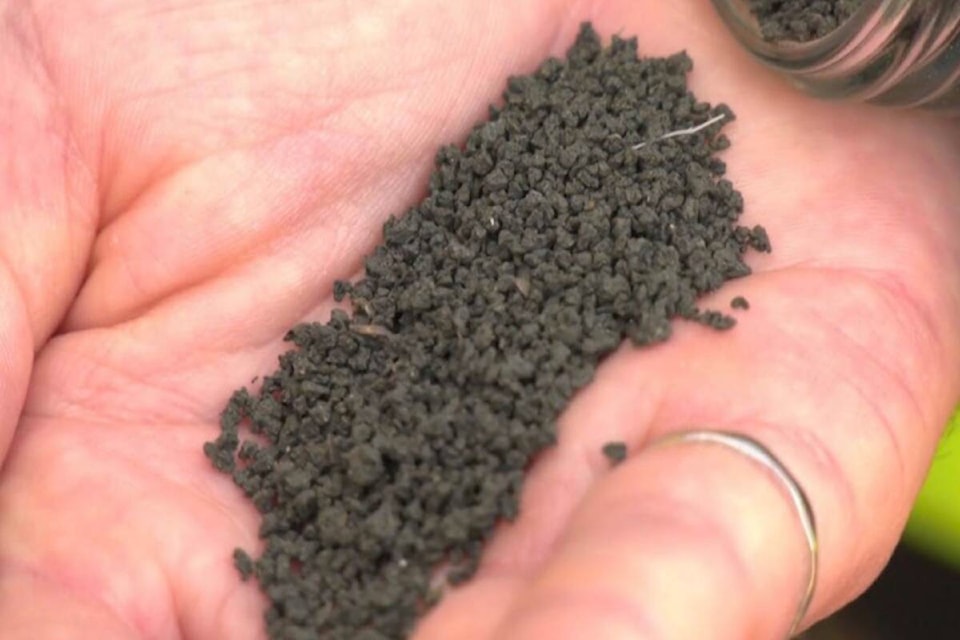Despite it already being a heavily debated short-term measure, the Capital Regional District’s long-term strategy for biosolids could mostly include spreading the treated sewage on the land.
The CRD has been struggling to find a reliable, short-term use for the dried-pellet biosolids as the province requires the region’s long-term plan to be submitted by next June. A report by the consultant GHD lays out the provincially required beneficial use options the CRD could take after 2025, but they largely include one’s the region is already looking at or has outright rejected.
The recommended options include continuing the region’s current strategy of sending them to a Richmond cement plant, multiple kinds of land applications that have stirred controversy or thermally processing the biosolids but spreading them on land as a backup.
“GHD recommends that the CRD develop a combination of multiple options within a diverse portfolio to ensure resiliency in the form of strategy redundancy,” the consultant’s report said.
A lack of resiliency has plagued the immediate strategy as issues at the Richmond site, and more recently at CRD facilities, have meant the cement plant hasn’t received biosolids for most of the last year and a half – leading to much of the treated sewage being landfilled.
All the portfolios presented by GHD include land applications either as the primary or backup options. The practise of spreading biosolids on land for uses like reforestation, industrial site reclamation or fertilization is supported by the province, used across B.C. and is the most prevalent biosolid management option worldwide.
But it’s a touchy subject on the South Island as multiple groups have long decried land application over concerns about public health and its environmental impact. The groups often cite the existence of forever chemicals, pharmaceuticals and other substances in biosolids, even if they’re at microscopic levels.
“Many jurisdictions around the globe are actively strengthening their regulations to limit land application of biosolids,” Jon O’Riodan of the Mount Work Coalition told CRD directors in June.
The CRD and upper levels of government maintain the risk of land application is low due to trace amounts of contaminants in biosolids being well below what’s considered harmful. They add biosolids provide nutrients that help plants or soils and can capture carbon emissions when properly monitored, regulated and applied to the land. GHD added the detection of contaminants of concern in biosolids doesn’t necessarily mean there’s a risk to human health or the environment.
GHD’s report also said a number of non-agricultural land application options in the CRD’s borders, like fertilizing forests, could be explored as long-term options. The CRD board in July reaffirmed its opposition to that idea. A CRD spokesperson said the province has said all options should be considered for long-term plan consultations and the board will consider the options at its next meeting.
Caetano Dorea, a University of Victoria engineering professor focused on wastewater treatment, said treating sewage doesn’t fully eliminate contaminants, but as with all things in life, it’s about getting down to an acceptable level of risk.
“I don’t think any Victoria resident would like to go more than one morning in which they’re not allowed to flush their toilets. We live in what one of the researchers in our team coined the porcelain dream,” he said.
The consultant’s report also looked at different kinds of thermal processing and found pyrolysis or gasification facilities at Hartland landfill could be long-term options, but they would need to be supplemented by land application to accommodate maintenance shutdowns. GHD also cautioned that by-products from the thermal sites - which will also need a beneficial use – may not be suitable for land application.
While the long-term plans must be in by next June, CRD staff have said it will take two to three years before a pilot thermal facility is operating. It would then run for 15 months, after which the results would be analyzed to see if it could be a long-term solution. A permanent facility would also require major plan amendments, consultations and provincial reviews, so staff said it could be up to 10 years until such a site is operational.
The consultant said thermal by-products like biochar have a host of beneficial uses, like boosting soil fertility, carbon sequestration and erosion control, but notes its impacts on soil are still being studied.
The CRD would also have to meet standards on the emissions created by the facility and will have to consider the overall energy it uses. Those are among the trade-offs policymakers will have to weigh as Dorea said the world of wastewater treatment is increasingly moving toward a resource recovery model.
He gave the example of California thermal projects creating biochar and having success with using it for plant growth and carbon capture.
“It’s almost like a carbon-negative approach to wastewater management.”
READ: CRD to continue trashing biosolids despite $100K per-month price tag
